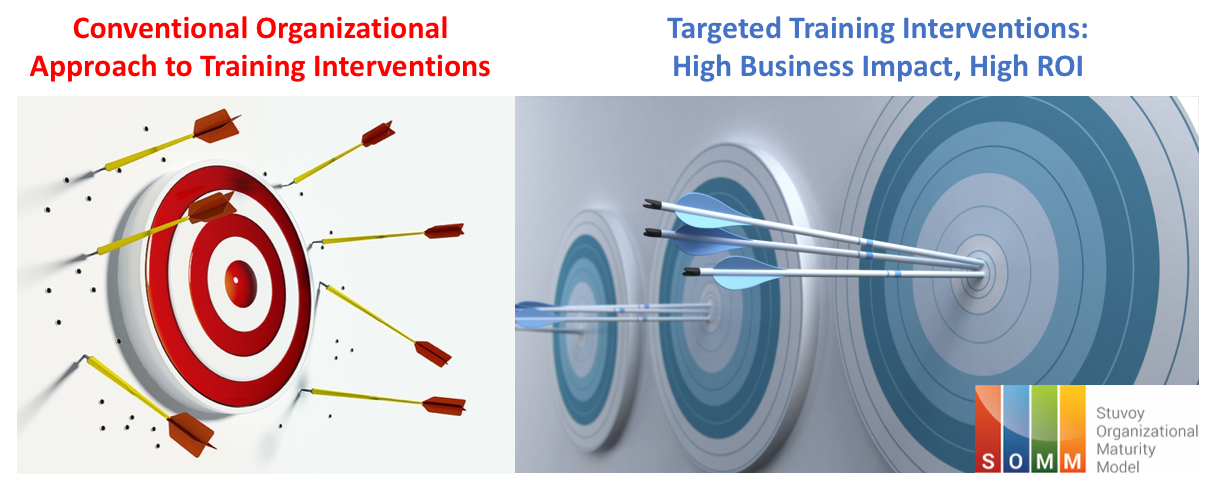 Corporate Training and Learning Development programs have primarily focused on broader training gaps in the past without the ability to ‘Penetrate’ and reach the core issue that needs attention.
Corporate Training and Learning Development programs have primarily focused on broader training gaps in the past without the ability to ‘Penetrate’ and reach the core issue that needs attention.
Why can't Training be precise to the need that an organization has? Why is it that we see blanket Training Interventions that add very little value to solving the core problem that the organization has? Organizations continue to ‘Carpet Bombard’ a group of like roles and expect results whereas the need is to be targeted with a ‘Surgeons’ Knife Precision’ approach in identifying the areas that need urgent attention.
There is an unmet need when assessing what Training Intervention needs to be prioritized first and where is the likely Business Impact that will yield maximum ROI.
Most of the Training Interventions attract diverse audiences, but the best training interventions ‘Target’ a specific need that is specific to an organization at a given point in time. Finding the right Targeted Training Need(s) and further customizing the Training Interventions such that specific levers are leveraged is a challenge that every organization grapples with.
Successful organizations in the new age have found the solution to the talent war: a highly ‘Customized and Targeted’ learning environment. The operative keyword being ‘Targeted.'
Successful organizations demonstrate the ability to create an ecosystem for learning and development that supports individualized training needs.
Targeted Training Interventions demand the use of established methods in identifying the training gaps, often going to the level of most basic building blocks. A Targeted Training intervention weaves the ingredients of Technology, Business Strategies, and Learning Objectives to create something that is highly tailored and effective in a real-world scenario.
The Design and Development process of a Targeted Training intervention requires a very meticulous understanding of the underlying business model, the services/ products being delivered and the nuances of integrating PEOPLE, PROCESS, and TECHNOLOGY.
SOMM (Stuvoy Organizational Maturity Model) is one such Framework and a Roadmap Model that makes possible the measurement of the maturity of PEOPLE, PROCESSES, and TECHNOLOGY. The term maturity in SOMM refers to the organization's readiness and experience about the three core pillars: Human Capital (PEOPLE), PROCESSES, and TECHNOLOGY.
With the availability of established frameworks and models such as SOMM, getting the right identification of a Training Intervention is a ‘Breeze’ for any organization. With SOMM, Organizations can look forward to impacting ‘Targeted’ business areas that have been a pain and have prevented the organizations from improving their Productivity, Quality, Reducing the Costs to market and an overall higher Retention of the client via higher satisfaction across services and products offered.
With Targeted investments in improving People, Processes & Technology, organizations are continuously and successfully sharpening the competitive ‘axe’ required to survive and thrive in the modern-day competitive world.
About the Author
Sanjeev Anand epitomizes a blend of an ideal ‘Corporate Leader’ and an expert ‘Corporate Trainer.' He is known for driving Organizational Growth and is a well-rounded professional carrying the rich experience of nearly Two decades touching corporate roles related to Brand Management, Marketing, Business Operations, Analytics and Strategy & Portfolio Development. Sanjeev has successfully built Global Brands, Created and Maintained a ‘Customer Focused Culture, 'Built Innovative Strategies to improve customer service, Delivered Customized Solutions Leveraging Technology while developing teams that provide bottom-line results by winning high-value analytics contracts. Sanjeev is known for bringing together the best of Technology, and Domain expertise to offer solutions to corporates that have till now seemed a distant possibility.






